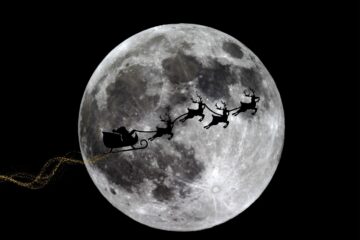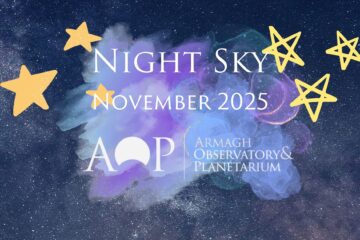Which is the brightest star in the sky (apart from the Sun)? Many non-astronomers believe that the Pole star (Polaris) is the brightest star but there are at least forty brighter stars. The correct answer is Sirius, a wonder of the winter sky.

The Sirius System: an artist’s impression of Sirius (Canis Major A) blazing in the darkness, while Sirius B (Canis Major B) shines less ostentatiously on the right. (Image Credit: NASA)
Finding Sirius in the winter sky is easy. First find the constellation of Orion. Pick out Orion’s belt, and follow the line the three stars in the Belt make leftward until you reach a bright star. How far do you need to go? Well, about 20° across the sky. That sounds complicated, but here is a quick tip. If you hold your hand at arm’s length, and extend your thumb and little finger, then the distance between the tip of your thumb and the tip of your little finger will be about 20 degrees. If the tip of your little finger is touching the end star in Orion’s belt (Alnitak), assuming you are using your right hand with the palm down, then your thumb will be close to Sirius.

From Armagh, Sirius is in the south eastern sky about midnight in early December (image credit: Armagh Planetarium)
Sirius is a member of the constellation Canis Major (‘The Big Dog’) and is often nicknamed the Dog Star. This comes from the Greek word ‘seirios’ which means “burning”, presumably it got this name from its blazing brightness. Sirius has been observed over the millennia and it was culturally significant to many ancient civilizations. The ancient Egyptians were particularly fond of Sirius, basing their calendar on when it rose over the horizon. Many websites claim that Sirius got its name from the Egyptian god Osiris, but this is a piece of recently-made-up New Age nonsense.
Sirius is a near neighbour of the Sun, just 8.6 light years (2.6 parsecs) away and is a bluish-white A class star about twice as massive as the Sun. Its surface temperature is about 9600°C (in comparison our Sun’s surface temperature is about 5500°C). Bizarrely, some historical accounts report Sirius as being red, and it is extremely hard to explain how this could have been. Any recent stellar transformation this complete would have been so drastic it would have left some trace we could observe today. We have to assume that there has been some kind of mistake made. Today Sirius is what proper astronomers call a ‘main sequence star’, meaning it is happily shining away generating energy from hydrogen. We expect Sirius will stay like this for another billion years or so.
Since the 1840s we have known that Sirius has an unseen companion. By observing the position of Sirius very carefully, astronomers noticed that the star was moving slightly in a predictable manner. It was clear that Sirius was being tugged by the gravitational pull of another object, so there was something else orbiting Sirius, too faint to be seen. However, telescopes were increasing in size and in 1862 the companion was seen for the first time. This odd little star is Sirius B (sometimes Sirius ‘proper’ is called Sirius A) or the Pup (since its bigger partner is the Dog Star) and is classed as a white dwarf.

An X-ray image of the Sirius system from NASA’s Chandra satellite. This image shows two sources and a spike-like pattern due to the support structure for the transmission grating. The bright source is Sirius B, the white dwarf star which produces very low energy X-rays. The dim source at the position of Sirius A may be due to ultraviolet radiation from Sirius A leaking through the filter on the detector. (Image Credit: NASA/SAO/CXC)
White dwarfs are not a clan of bearded mini-Vikings from ‘The Lord of the Rings’, they are old stars on their very last legs. All the stars we can see with the naked eye are shining because they are ‘burning’ the gases they are made up of. I say ‘burning’ rather than burning, because this is a nuclear process, not what goes on in your fireplace. Most stars are mainly hydrogen and deep in the hot pressure cooker of their interiors, hydrogen atoms are fusing together, forming helium atoms and giving out energy as a by product. For all but the largest stars this can go on for billions of years until all the hydrogen is used up and the star is said to be on the main sequence.
When the star’s hydrogen fuel is all gone, the star has no choice but to begin ‘burning’ helium instead. As it ‘burns’ helium, the star swells up enormously into a red giant star (red giants are not characters from the works of JRR Tolkein either, Aldebaran in Taurus and Betelgeuse in Orion are examples of red giant stars), it is still shining but the end is in sight. Once the red giant has ‘burned’ up its helium it basically gives up: with a final despairing wheeze it blasts its outer layers off into space forming a planetary nebula.
At the centre of the nebula is a very hot speck, a white dwarf, essentially this is the core of the defunct star. The white dwarf will shine on for a very long time (trillion of years in fact) but it is to all intents and purposes dead. It is not actually generating energy anymore, just radiating off heat it accumulated while it was alive. This means the white dwarf is gradually cooling and eventually, after a very long time, will end up as a cold, dark cinder which will just sit there doing nothing essentially forever. The best estimates suggest Sirius B has been a white dwarf for about 120 million years.
White dwarfs are very compact objects, usually about half the Sun’s mass is squeezed into a volume as big as the Earth. Sirius B is actually unusual as it is about as heavy as the Sun. Squeezing so much stuff into a tiny space means it is very dense, you couldn’t use a tea spoon to scoop up a sample of Sirius B, as your spoonful would weigh about five tonnes! Sirius B’s surface temperature is about 25 000°C, much hotter than Sirius A or indeed our Sun. Again, that is because it is so small, all the heat is concentrated into a small volume. Sirius B swings around Sirius A in an eccentric orbit. Their separation varies from 8 to 30 AU, so if Sirius B was a member of our solar system, its orbit would take from inside the orbit of Saturn to as far out as Neptune. By the way, for more than a century some astronomers have reported apparent orbital irregularities in Sirius B, suggesting there may be a third very small star in this system, but this has never been confirmed.
You may remember that I said as it uses up the hydrogen in its core in the next billion years or so Sirius A will stay on the main sequence. After that period, it too will inflate up into a red giant until all its helium is gone. Once that happens, Sirius A will persist as a white dwarf, orbited by its fellow white dwarf for aeons to come.
Apart from Sirius, to be brutally honest there is nothing else really interesting in Canis Major. There are seven more stars, none especially significant and M41, a faint open cluster. You will need a very dark sky to find M41 and afterwards you may not think it was worth the trouble. So what else is worth pointing out in the vicinity of Sirius? About 25° above Sirius (do the trick with your hand I mentioned earlier to gauge the distance) you will find another bright star. This is Procyon, the eighth brightest star in our sky. Procyon means “before the Dog” because to people in the northern hemisphere it rises before Sirius. It is a member of Canis Minor (‘the Little dog’) a frankly pathetic little constellation consisting of Procyon and one other easily spotted star (Gomeisa). Procyon has some similarities to Sirius – note these are purely coincidental – Procyon is also a near neighbour of the Sun being about 11.4 light years away (3.5 parsecs). Procyon also has a white dwarf companion which orbits it about as far away as Uranus is from the Sun. However, Procyon is very different from Sirius, being a yellow F class main sequence star about 1.5 times as massive as the Sun and about 7.5 times as bright as the Sun. It seems to be a relatively young star, perhaps only around 1.7 billion years old, but it will not last as long. As it is so bright, Procyon must be using up its stockpile of hydrogen very quickly and will soon enter its red giant phase. In fact, this may be happening at this very moment, as Procyon is unusually bright for a star of its class.
Together with Betelgeuse in Orion, Sirius and Procyon make up an asterism called the Winter Triangle. Why not take a tour of the highlights of the winter, leaping from Sirius to Procyon, then to the wonders of Orion and Taurus?



4 Comments
Clifford Lalonde · January 18, 2013 at 05:35
thank you for the info…will have to visit this site again.I sometimes see what,to me, is a giant triangle…not sure what it is. I know where to look for some constellations…orion,pliedes,cassiopia….I think the ancients must have used constellations to indicate seasons. It seems strange to go out,look up,and,what I see,was seen by all who came before me….from the very first.
Best regards
Clifford
Paul Evans · December 13, 2011 at 10:02
Thanks for that article Colin – interesting and informative as always!
There is one other star in Canis Major that I find fascinating, although I agree it’s visually unspectacular, and that is Delta Canis Majoris, or Wezen. Although it’s a very average looking star, a bit brighter than Polaris, it is very far away and in absolute terms is one of the brightest stars in the sky. Indeed if it were at the distance of Sirius, it would be visible in daylight being of magnitude -8 or thereabouts. So not much to look at, but stretches the imagination a bit!
Paul.
February Night Sky Wonders | Astronotes · February 6, 2014 at 10:12
[…] Major, Orion’s great hunting dog. More on Canis Major and the brightest sparkler in the sky, Sirius can be found here. A line eastwards from Betelgeuse marks Procyon, one of two stars that represent […]
Sydney, Australia Adventures in the Werewolf of Oz | Free and Equal Green Writing · April 15, 2013 at 09:19
[…] we made our way across Harbour Bridge to the north, with great views of starry Little Sirius Cove below. Pebbles glinted in the sunshine like stars on a clear […]